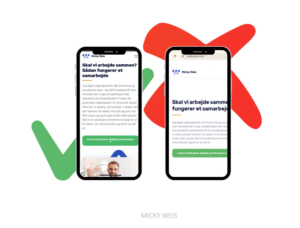
For most websites, the majority of their searches come from mobile devices, which has led many to prioritize the mobile-friendliness of their site.
In other words, how do you create a user-friendly experience on your website for those users who visit using mobile devices?

End bad mobile results
Google has embraced mobile-friendliness and optimized their search engine for mobile use with an update called Mobile First Index.
This update has made it necessary for websites that want to maintain their ranking in Google’s search engine to optimize their site for mobile use.
Mobile first index
With Google’s Mobile First Index update in 2021, it became clear that the search engine would only display results from their indexing of mobile-friendly websites – regardless of whether the user is searching from a desktop, mobile, or tablet.
In this way, the mobile version of a website will entirely determine its ranking in Google’s search results.
In other words, mobile-friendliness will be crucial for achieving a favorable ranking among search results.
And simply creating a mobile version of your site with reduced content won’t be enough. All elements included in the desktop version should also be present in the mobile version in a scaled and adapted format.
What is the key to topping the search results? Read my comprehensive guide to SEO here.
How to make a website mobile-friendly
To make your website mobile-friendly, there are several things you can do.
The first and most obvious is to use responsive design for your site. This ensures that your website automatically adapts and scales to the device in use.
This way, you ensure a user-friendly experience on your website with the possibility of tailored interaction, no matter which device is used to interact with your site.
User-friendly and flexible layout
A user-friendly and mobile-friendly interaction will also include easy navigation on your site, with touch-friendly buttons and a streamlined layout.
Additionally, a fast loading time for your site will be crucial in preventing users from quickly leaving your website.
A high bounce rate often results from slow loading times, which can be mitigated by optimizing images, files, and other elements on your site for mobile use.
All in all, mobile-friendliness is simply essential for whether your website will achieve a favorable ranking in Google’s search results in the future and thus be visited by users.
It can therefore be beneficial to ensure continuous mobile optimization of your site and to run tests to check if your website’s mobile version offers a user-friendly experience across devices.












Comments